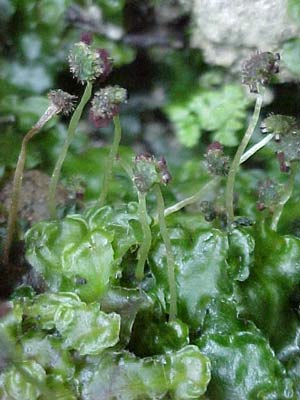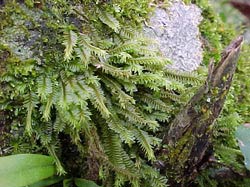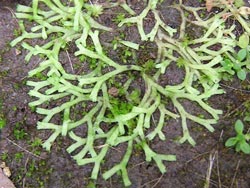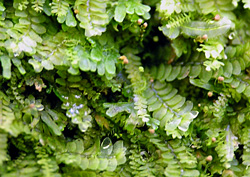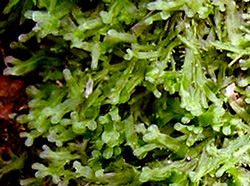
|
"Briología en el INECOL" Dr. Efraín De Luna, Depto. Biodiversidad y Sistemática, INECOL, Xalapa, Ver |
|
Las Hepáticas |
|
Superdivision Marchantiomorpha División Marchantiophyta (Reino Chlorobiota Subreino Streptobionta Infrareino Embryobiotes) Este grupo de briofitas es muy diverso (más o menos 8 000 especies), pues incluye tanto las formas talosas como las foliosas. La diversidad se ha clasificado en seis ordenes: Jungermaniales, Marchantiales, Metzgeriales, Monocleales, Calobryales y Sphaerocarpales. Algunos de los géneros más conocidos son: Marchantia, Plagiochila, Frullania y Metzgeria. Caracteres del grupo. i. Cuerpos de aceite (oleosomas) en las células del gametofito. ii. Eláteres entre las esporas. iii. La presencia de ácido lunulárico se ha interpretado como una sinapomorfia para las Marchantiophyta, pero queda la duda si este compuesto también está presente en algunas algas verdes, las cuales no se han estudiado (Kenrick y Crane 1997. p. 69). Relaciones dentro del grupo. Las relaciones filogenéticas entre los seis subgrupos de hepáticas son muy inciertas. Únicamente se ha podido reconocer la relación de grupos hermanos entre Metzgeriales (talosas simples) y Jungermaniales (foliosas). Las relaciones entre los otros cuatro órdenes y éste último grupo aún no están resueltas. |
Dumortiera
Riccia
Leucolejeunea
|
|
REFERENCIAS Kenrick P. y Crane P. R. 1997. The origin and early diversification of land plants: a cladistic study. Smithsonian Institution Press. Washington D.C., USA.
Goremykin, V. V. & F. H. Hellwig. 2005. Evidence for the most basal split in land plants dividing bryophyte and tracheophyte lineages. Plant Systematics and Evolution 254: 93-103. Abstract The problem of relationships among the major basal living groups of land plants is long standing, yet the uncertainty as to the phylogenetic affinity of these lines persists in the literature. Molecular and modern cladistic studies of the phylogenetic relationships of the above groups resulted in a large number of conflicting topologies. However, with the exception of the cladistic analyses of spermatogenesis, suggesting monophyly of extant bryophytes, these studies agree the paraphyletic bryophyte grade is basal within the embryophyte tree. Here we would like to present analyses on the basis of the concatenated datasets of nucleotide and amino-acid sequences of 57 protein-coding genes common to 17 chloroplast genomes of land plants and a charophyte alga Chaetosphaeridium globosum. Character-wise, these are the largest datasets currently available to address the problem of basal relationships within embryophytes. Main lineages of bryophytes, i.e liverworts, hornworts and mosses are represented in our alignments with a single taxon, whereas 14 taxa represent the tracheophytes. With our data, phylogeny with liverwort basal appears to be and artifact related to high and unequal A+T contents among the sequences analysed. Reducing this compositional bias and applying methods developed to counter it, we recovered an alternative, strongly supported topology wherein both bryophytes and tracheophytes are monophyletic. Within bryophytes, hornworts are basal and liverworts are sister to mosses. Keywords Bryophytes - chloroplast genomes - molecular evolution
Lewis LA, BD. Mishler & R Vilgalys. 1997. Phylogenetic Relationships of the Liverworts (Hepaticae), a Basal Embryophyte Lineage, Inferred from Nucleotide Sequence data of the Chloroplast Gene rbcL. Molecular Phylogenetics and Evolution 7: 377-393. Abstract. Sequence data from the chloroplast-encoded generbcL were obtained for 24 liverworts, a basal group of embryophytes. Maximum likelihood and parsimony analyses of these data, along with data from other major green plant lineages, confirm hypotheses based on morphological data, such as the paraphyly of bryophytes, and the basal position of liverworts. Molecular data corroborate the deep separation between the complex thalloid and leafy/simple thalloid liverworts implied by morphological data, but the monophyly of liverworts could not be rejected. The effects of accounting for site-to-site rate heterogeneity in these data were examined using maximum likelihood methods. Comparison of trees obtained with and without rate heterogeneity showed that simply allowing for heterogeneity had a greater improvement on likelihood score than optimization of transition/transversion bias. Incorporation of site-to-site rate heterogeneity in the larger analysis, however, did not necessarily change which topology was favored. Properties ofrbcL sequences from the two liverwort groups were compared. Significantly different substitution rates were found between leafy/simple thalloid and complex thalloid liverwort taxa, with rates ofrbcL sequence evolution in leafy/simple thalloid taxa being higher and more indicative of those of vascular plants, and with those of complex thalloid taxa (such asMarchantia) being slower. Codon usage inrbcL in complex thalloid liverworts was biased toward NNU and NNA, compared to the leafy/simple thalloid liverworts. Although base composition and relative substitution rates differed between the two groups, no significant differences were detected within each of the two groups of liverworts. The signal present in first and second codon sites versus third codon sites was compared. While the third codon positions inrbcL across this taxon sampling are highly variable (with only 15 constant sites of 439), the trees obtained were in general agreement with trees from the entire data set and with trees obtained from independent sources of data. The presence of signal in third codon positions across greater than 400 MY of plant evolution means that definitions of saturation based on pair-wise comparisons of sequences inadequately assess phylogenetic signal.
Wheeler JA. 2000. Molecular Phylogenetic Reconstructions of the Marchantioid Liverwort Radiation. The Bryologist: Vol. 103, No. 2 pp. 314–333 Abstract Molecular phylogenies of the complex-thalloid liverworts (Marchantiales) were reconstructed using independent nuclear and plastid data sets to explore relative age, relationships, and character evolution in this ancient group. The sample includes 10 carpocephalate taxa and 24 acarpocephalate taxa (emphasizing Riccia) within Marchantiales sensu stricto. In addition, Monoclea, Sphaerocarpos, Riella, three Metzgeriales (Fossombronia, Pellia, and Blasia), the hornwort Anthoceros, four mosses, and outgroup Coleochaete are also sampled. Two nucleotide sequence alignments were used 1) partial nuclear-encoded Large Subunit rDNA (LSU rDNA) for all 48 taxa and 2) the plastid-encoded trnL-F region for the marchantioids and outgroup Blasia. Alignment-ambiguous regions of each alignment were culled. A combined matrix consisting of concatenated nuclear and plastid culled alignments was assembled for marchantioids and Blasia. The two alignments were utilized in four analyses: 1) nuclear LSU rDNA for all taxa, 2) nuclear LSU rDNA for marchantioids + Blasia, 3) plastid trnL-F region for marchantioids plus Blasia, and 4) combined nuclear and plastid data for marchantioids plus Blasia. Selected pairwise comparisons reveal significant rate heterogeneity in the nuclear LSU rDNA data; metzgerioid liverworts, hornworts and primitive mosses evolve significantly slower than other taxa relative to the outgroup Coleochaete. The LSU rDNA genes of some marchantioid taxa and sampled bryalean mosses are apparently evolving relatively fast. Rate heterogeneity is also documented within Marchantiales. Lunularia positions as the most basal of sampled Marchantiopsida; Sphaerocarpales, Marchantia, and Corsinia represent early diverging lines. A monophyletic Aytoniaceae, Cleveaceae, and Riccia are indicated. Topologies imply that extant acarpocephalate taxa are derived from carpocephalate forms. Monoclea positions well within Marchantiales sensu stricto. A well-supported long branch (Decay Index = 19) unites all sampled Marchantiopsida and isolates this clade from other liverworts and bryophytes. This long branch may suggest extensive extinction of proto- and eomarchantioid forms that led to modern taxa. A recurring theme in the topologies presented here is the unresolved marchantioid polytomy that follows well-supported basal nodes. A similar polytomy results from either independent data set and may correspond to a rapid radiation of marchantioid forms (e.g., Aytoniaceae, Cleveaceae, Targionia, Monoclea, and riccioids) coincident with extreme conditions and ecological reorganizations of the Permo-Triassic. The origin of Marchantiopsida probably occurred long before; amidst, perhaps, a series of long-extinct Blasia-like ancestors that colonized and innovated on any of various xeric surfaces (either cool or warm) that were available throughout embryophyte history in the Paleozoic. |
